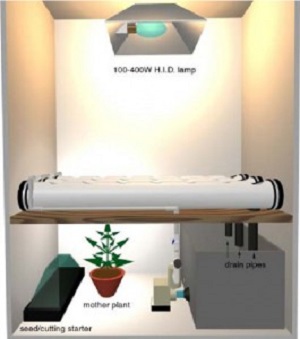
With hydroponics growing almost any plant indoors and to full effect is possible. Many flowers, herbs, and leaf-only plants are able to be grown indoors using a hydroponic setup without any other additional features. The simple use of hydroponic grow nutrients and a soil-free grow medium such as expanded clay or rockwool is all that is needed. For plants that require sunlight to grow to their full potential, grow lights would be required as well. Growing hydroponics plants indoors is a great solution to areas that experience harsh or prolonged winters and for gardeners that want to grow plants out of their normal outdoor season.
Growing plants hydroponically and indoors is only a simple extension to growing them outside. If there is sufficient space, any hydroponics system can be used indoors just as well as it would work outdoors. Water culture, drip systems, ebb & flow systems, the nutrient film technique and aeroponics can all be used almost as is in an indoor environment. The only additional item that would be required is a lighting system. The type of lighting that is required is dependent on the type(s) of plant(s) that are to be grown. If they are mainly vegetative plants (that don’t produce flowers or fruit) such as lettuce, cabbage, herbs, or flower-less plants, a metal halide lamp is ideal, as it emits predominantly blue light, which is required for vegetative (leaf and stem) growth. If there are mainly flowering or fruiting plants to be grown, a high-pressure sodium lamp is ideal, as it emits predominantly red light, which is required for plants to flower and/or fruit. This article describes the different types of hydroponic lighting systems.
The Closet Garden
There are a number of indoor spaces such as closets, basements, attics, or under stair cases that are commonly unused or otherwise used to store unwanted items. These spaces can be transformed into indoor herb or vegetable gardens with the use of hydroponic technology. The photo in this article shows a closet hydroponic garden design that uses the nutrient film technique. The entire system is set up inside a closet and consists of a nutrient reservoir, PVC and drain pipes, a water pump, nutrient feed lines and a high intensity discharge (HID) lamp. In this example, a seed/cutting starter is also shown, in which seeds and/or cuttings can be propagated until they develop a root system that is sufficient in size to sustain the plant once it is transplanted into the hydroponics system. A mother plant is also shown, which is used as a source of cuttings that can be used to rapidly replace plants in the hydroponic system once their yield starts to drop.
While this is a system based on the nutrient film technique, any type of hydroponic system would be suitable. The type of hydroponics system that is used should be chosen based on the benefits and disadvantages of each system in relation to the type(s) of plant(s) that are to be grown. This article discusses the seven most common hydroponic systems.
When growing hydroponics plants indoors, it is important to consider a number of things. First, the use of grow lights will undoubtedly increase the surrounding temperature, particularly in confined spaces such as closets or under stair cases. Ventilation might be required to minimize this so the plants don’t become too hot and inadvertently stressed. Second, growing plants in confined spaces means that there is limited ventilation. This limits the supply and removal of oxygen and carbon dioxide. If ventilation is not sufficient, a fan or exhaust system might need to be considered so this does not become an issue. The final thing to consider with the use of hydroponics systems indoors is safety. Lights and pumps are powered by electricity and therefore any installation needs to be carried out by a certified electrician to minimize the possibility of electric fires. Plants will also need to be checked regularly and cut back if they grow too close to the light. The nutrient reservoir and fluid lines may be prone to leaks, which would obviously cause unwanted mess should a leak occur. Measures to minimize the likelihood of leaks, and even better, measures to contain leaks should they occur, should be taken. This can be done as simply as sitting the entire hydroponics system in a tray that can hold the entire nutrient volume in case there is a leak.
Growing hydroponic plants indoors creates the possibility of growing plants during times of the year that are otherwise unsuitable for gardening, and also makes essentially any area of the home such as closets or under stair cases useable. Any hydroponics system design is able to be adapted to use indoors, and if required (for plants that normally grow outdoors), grow lights can be used to provide sufficient light to allow plants to grow optimally indoors.
Pavel Sluka has been growing hydroponically for over 20 years.
Related Articles & Free Email Newsletter Sign Up
3 Common Hydroponic System Problems and How to Fix Them
The Importance of Ventilation in Hydroponics
pH Testing in Hydroponics is Easy and Leads to Larger Yields




Comment here